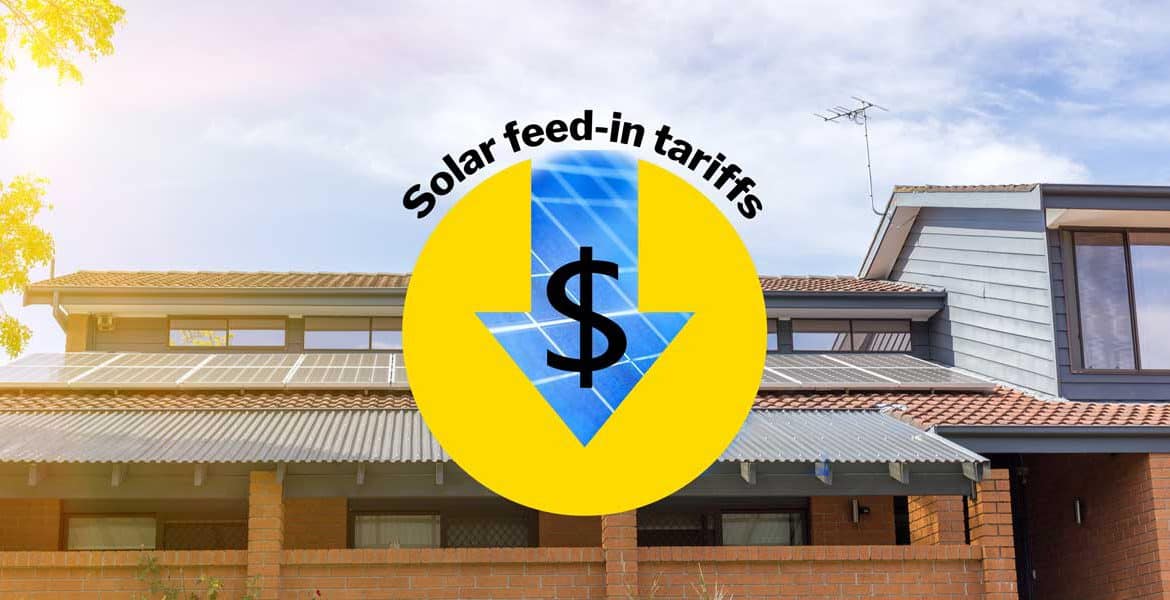As most solar owners know, solar feed-in tariffs (FITs) have continued to fall in 2021. This article explains why that has happened, why this will continue, and most importantly, what solar owners can do about it.
There are plenty of effective strategies to get value from solar in a low feed-in tariff world.
Why are solar feed-in tariffs falling?
Knowing why FITs have fallen can make it easier to appreciate where we are now. Reductions in FITs have been driven by ongoing low wholesale prices in the National Electricity Market (NEM) during the middle of the day. This is when solar is being exported into the grid by households, businesses and large solar farms. In fact, the high volume of energy available to the market during daylight hours exceeds demand. Because wholesale prices in the electricity market respond to supply and demand, spot prices in the NEM often become negative during the midday solar peak. At times, electricity sellers (generators) pay energy buyers to take their electricity.
Households and all but the biggest businesses buy their energy through retailers. The prices they pay for electricity, including the feed-in tariffs on offer, is fixed by the retailer using various market contracts. In 2021, retailers can purchase electricity in the wholesale market, particularly during the daytime, at very low rates – generally, under 5c per kWh. What happens if a retailer decides to pay more than the market price to buy solar exported by households or businesses? Ultimately the retailer must either increase the rates they charge (usage rates, daily supply charge etc.) or lose money.
Why high FITs couldn’t continue
Some retailers continued to pay high feed-in tariffs in recent years. AGL’s Solar Savers offered feed-in tariffs around 20 cents per kWh, while Origin Energy’s Solar Boost plan was similar. In the case of AGL, the retailer was paying far more to households than the electricity was worth in the market. AGL undoubtedly lost money on a portion of their solar customers (high export, lower grid use households) on these plans. Clearly, this situation couldn’t last forever.
The ‘big solar’ plans now offer feed-in tariffs around 10-12 cents, plus a limit on solar PV size (10kW). The plans also come with higher usage and supply charges. This is to make up for the “losses” the retailer incurs, paying 5-10c per kWh over the market rate.
It was good while it lasted.
Whatever you think of energy retailers – and there’s not a lot of love out there – it has to be recognised they played a part in Australia’s massive uptake in solar. AGL, Origin Energy and other big FIT retailers actively rewarded solar owners. Their high feed-in tariff plans improved the payback periods for solar owners. However, there is no doubt that these retailers lost money on solar households savvy enough to take advantage of these plans.
While as solar owners, we like to think our zero emissions exported electricity is valuable. Unfortunately, the market is oversupplied in the middle of the day. So, until something changes – like coal-fired power stations exiting the market – the oversupply will continue. Expect daytime wholesale prices to remain low, bringing solar FITs with them.
What are my options now solar feed-in tariffs have fallen?
There are several strategies available to households to mitigate the financial impact of falling feed-in tariffs.
Broadly these are:
- If you’re still on a high feed-in tariff plan, sit tight and enjoy it while it lasts
- Seek out solar sweet spot deals (either uncapped or capped depending on your system and export volume)
- Use more of your own solar by shifting when you consume electricity
- Store your solar in a battery (home storage or an electric vehicle)
I’ll unpack each of these approaches in more detail.
1. Still on a great FIT, sit tight
If you’re already onboard a high fit plan, enjoy it while it lasts. But reset your expectations for what’s next. AGL Solar Savers and Origin Energy Solar Boost come with 12 month benefit periods. As far as we know (based on past and current customer experience), the stated benefit periods have been honoured. The experience has been that customers have only been moved to lower feed-in tariffs once the benefit periods have expired. If you’re on uncapped feed-in tariffs above 15c per kWh, it’s unlikely you’ll find a better deal in the market if you’re exporting more than 10-kWh per day. For those on these plans, hang in there while it lasts.
2. Seek out the sweet spot solar deals.
If your plan has dropped FIT and it’s time to consider your options, the best strategy is to focus on plans that deliver the lowest overall cost. It will be the combination of lower usage and supply charges mixed with a reasonable solar feed-in tariff that achieves this. A personalised comparison for your unique usage and export will show you the leading options plans for your situation.
3. Use more of your own solar
Solar feed-in tariffs are likely to be a lot less than half the cost of buying electricity. So if you can shift any loads from evening to daytime, this will reduce the need to purchase power from the grid. Think cooling, heating, pool pumps, washing machines, dryers, electric vehicle charging. All these loads are candidates to be moved to the middle of the day to soak up excess solar – making you more self-sufficient. And crunching your energy bills.
If you’re in a network with solar sponge tariffs, then any excess power needs above what your solar can cover will only be charged at off-peak rates. See solar sponge plans page here.
4. Store your solar in a battery – either fixed or on wheels
As feed-in tariffs fall, the economics of batteries improves. Batteries allow households to use excess solar at a few cents to save buying from the grid at 15-40c per kWh, depending on your location and electricity plan. And with the support of payments for joining a Virtual Power Plan (VPP), payback periods for well-sized batteries coupled with time of use tariffs are coming down. In many States, a payback period of 10 years or less is achievable. Additionally, some state governments offer rebates and loans to help reduce the upfront costs of batteries. You can find out more with WATTever’s Battery Storage Buyers Guide.

My journey
When we launched WATTever in 2017, retailer feed-in tariffs were nearing their peak. Thanks to having visibility of plans from all retailers through WATTever’s whole-of-market comparison service, our household has been able to ride the wave of high feed-in tariffs into 2021. Here’s a rundown of what we’ve done to mitigate falling feed-in tariffs; > Hung onto a 25 cent feed-in tariff up until April 2021 (AGL Solar Savers, Discover Energy VPP)> Sought out the best overall deal – in our case, a VPP offering above-average feed-in tariffs and energy trading
> Shifted loads to the daytime for heating, cooling, hot water and EV charging
> Invested in a fixed battery (2019) and battery on wheels (Model 3)
What’s next for Solar FIT’s
As the retail electricity market lags the wholesale electricity market, we can predict future retail rates and feed-in tariffs. And, at least at a generation level, the trends are clear. Increasing installations of renewable energy will put downward pressure on wholesale rates in the middle of the day. Wholesale rates in NSW, ACT and Victoria will follow South Australia and Queensland. During peak solar generation hours – the wholesale rate is forecast to average under 3c per kWh.
As the oversupply of daytime electricity increases, solar owners will receive less and less from exporting it back into the grid. Expect average feed-in tariffs to fall under 5 cents. Then to around 1-3 cents – which leading low-cost retailers such as ReAmped Energy and GloBird Energy already offer solar-soaked South Australia.
To some degree, this will make the whole “solar tax” debate around charging solar owners for “export services” moot. With daytime feed-in tariffs trending to zero, an increasing number of consumers (Amber and Powerclub customers on market-linked plans already face this) will be paid nothing for much of their exported solar.
Will decent feed-in tariffs ever make a comeback?
Ultimately, feed-in tariffs will stabilise when there is a better balance of supply and demand in daylight hours. Either we:
- Decrease supply. For example, moving away from inflexible generation such as coal-fired power stations.
- Increase demand. For example, charging batteries and electric vehicles.
In terms of decreasing supply, the market is already driving this. Coal generators are losing billions of dollars a year due to the low and often negative wholesale prices. As a result, many coal generators are bringing forward their planned closure dates. Unfortunately, investment in renewables, particularly solar, is also falling from its peaks in 2019/2020.
In terms of increasing demand, there are many large scale battery programs underway. This will begin to soak up some of this excess power. However, as with solar, there is the opportunity for households to play a significant role by;
Shifting our consumption to daytime hours when renewable energy is both cheap and plentiful. Moving to a solar sponge tariff if it’s available in your network can help too.
Storing our excess solar in batteries both fixed and portable (EVs). Our solar becomes more valuable to us when stored in a battery and available whenever we want compared to the value the market will provide for daytime solar export.
Want more idea for getting the most from solar
Head here for helpful resources to assist in maximising returns on your solar:
Choosing an electricity plan for solar owners

